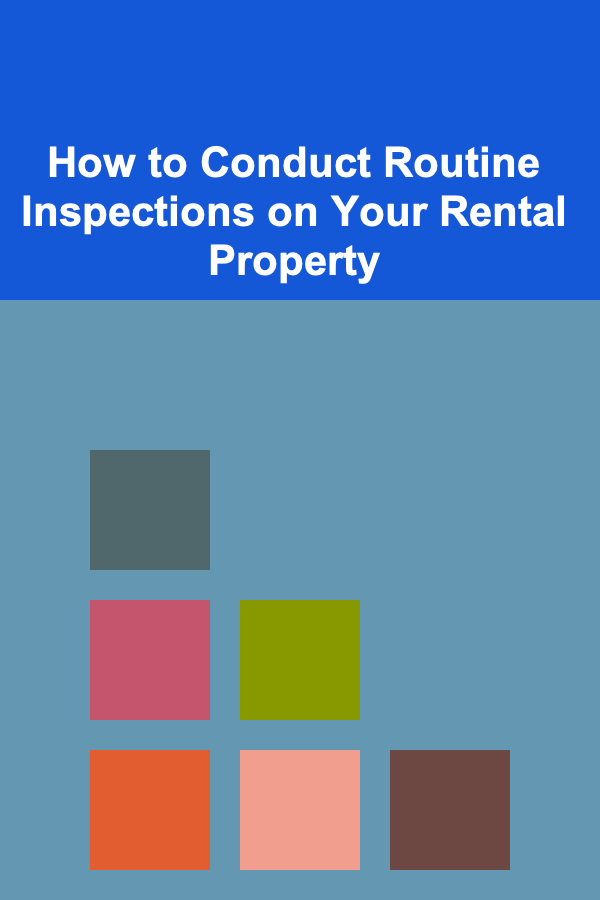
How to Conduct Routine Inspections on Your Rental Property
ebook include PDF & Audio bundle (Micro Guide)
$12.99$6.99
Limited Time Offer! Order within the next:

Routine inspections are an essential part of property management. Whether you're a seasoned landlord or a first-time property owner, regularly checking the condition of your rental properties ensures that both you and your tenants are protected. By conducting routine inspections, you can spot potential problems before they become major issues, maintain the property's value, and ensure that your tenants are living in a safe and healthy environment. However, carrying out these inspections requires careful planning, adherence to legal requirements, and respect for tenant privacy.
In this article, we will explore the importance of routine inspections, the steps involved in conducting effective inspections, the best practices to follow, and how to manage tenant communication throughout the process. We'll also look at the legal aspects, frequency of inspections, and how to handle any issues that may arise during the inspection.
Why Routine Inspections Matter
Routine inspections offer multiple benefits for landlords and property managers. Here are some of the key reasons why you should make regular inspections a priority:
1. Preventative Maintenance
One of the most significant benefits of routine inspections is that they allow you to spot minor maintenance issues before they escalate into expensive repairs. For example, spotting a leaking pipe or faulty electrical wiring during an inspection can prevent significant water damage or electrical hazards. By addressing these issues early, you'll save both time and money in the long run.
2. Ensuring Tenant Compliance
Routine inspections help you ensure that your tenants are following the terms of their lease agreement. This includes checking for unauthorized pets, unapproved subletting, or excessive damage to the property. By monitoring the condition of your rental unit, you can spot potential lease violations and address them promptly.
3. Safety and Habitability
Inspecting your property allows you to check that your rental is safe and habitable. You need to ensure that fire alarms, carbon monoxide detectors, and other essential safety equipment are functioning properly. This is not only for the safety of your tenants but also to comply with local building codes and landlord-tenant laws.
4. Maintaining Property Value
Routine inspections are essential for maintaining the long-term value of your property. Regularly checking for issues such as mold, pest infestations, or structural damage can help protect the property from deterioration, which could negatively affect its value. Maintaining the property in good condition also helps you attract high-quality tenants who are willing to pay competitive rent.
5. Documenting the Condition of the Property
By conducting regular inspections, you create a record of the property's condition over time. This documentation can serve as valuable evidence in case of disputes with tenants regarding damage, security deposits, or lease violations. It also provides a reference point for comparing the property's condition when a tenant moves out, helping you avoid disputes during the move-out process.
Legal Considerations for Routine Inspections
Before you begin conducting routine inspections, it's essential to understand the legal requirements and restrictions surrounding them. Tenant rights vary depending on the country, state, or region you're operating in, so it's crucial to familiarize yourself with the local landlord-tenant laws. Below are some general legal considerations:
1. Notice Requirement
In most jurisdictions, landlords are required to give tenants advance notice before conducting an inspection. The amount of notice varies, but it is typically 24-48 hours. This notice period is designed to respect tenant privacy while also allowing landlords to prepare for the inspection. The notice should be clear, indicating the date, time, and reason for the inspection.
2. Tenant Consent
While landlords generally have the right to inspect their properties, tenants have the right to quiet enjoyment of their homes. This means that a tenant's consent is usually required before an inspection can take place, even if notice has been given. If a tenant refuses to allow the inspection, landlords may need to seek legal intervention or apply to the court, depending on local laws.
3. Reasonable Hours
Inspections should be conducted during reasonable hours, typically during the day on weekdays. Conducting inspections outside of these hours may be viewed as harassment or an invasion of privacy. Always aim for a time that is convenient for the tenant, and be sure to accommodate their schedule where possible.
4. Purpose of Inspection
Landlords must have a valid reason for conducting an inspection. Valid reasons may include routine maintenance, health and safety checks, or verifying tenant compliance with the lease. Inspections cannot be used as a pretext to harass tenants or invade their privacy. Always ensure that the purpose of the inspection is clear and legitimate.
5. Tenant's Presence
In most cases, tenants are entitled to be present during an inspection. You should ask the tenant to be available during the inspection, or at least give them the option to be present. Some landlords may choose to inspect a property while the tenant is away, but this is only acceptable if the tenant has given their consent in advance.
How to Conduct a Thorough Routine Inspection
Conducting a routine inspection involves much more than simply walking through the property. A thorough inspection requires preparation, attention to detail, and a systematic approach to ensure that you don't miss any potential issues. Here's a step-by-step guide to help you conduct an effective inspection:
1. Prepare for the Inspection
Before heading to the property, gather all the necessary materials you will need during the inspection. These may include:
- Inspection Checklist: Create a detailed checklist of all the areas you want to inspect, such as appliances, plumbing, electrical systems, and safety equipment. This helps you stay organized and ensures you don't overlook anything.
- Camera or Smartphone: Take photos of the property's condition to document any issues or damages you notice. This can serve as evidence if there are disputes later.
- Repair Supplies: If you know of minor issues that can be fixed on the spot, bring the necessary supplies with you (e.g., light bulbs, batteries for smoke detectors, etc.).
- Tenant Contact Information: Make sure you have the tenant's contact information in case of last-minute changes or delays.
2. Conduct the Inspection
Start by conducting a visual walkthrough of the property, checking both the interior and exterior. Follow your inspection checklist to ensure that no area is overlooked. Key areas to inspect include:
Exterior Inspection
- Roof: Check for missing or damaged shingles, leaks, and other signs of wear.
- Foundation: Look for cracks or signs of settling that could indicate structural issues.
- Walls and Windows: Inspect the exterior walls for cracks, mold, or water damage. Check windows for cracks or broken seals.
- Landscaping: Ensure that the lawn and landscaping are well-maintained and free of hazards like overgrown trees or bushes.
- Pest Infestations: Look for signs of pests or rodents, such as droppings, nests, or damage to the property.
Interior Inspection
- Plumbing: Check for leaks under sinks, around toilets, and near water heaters. Inspect water pressure and drainage.
- Electrical System: Test light switches, outlets, and appliances. Ensure that the electrical system is functioning safely and properly.
- Heating and Cooling: Verify that the HVAC system is working effectively. Check filters and vents for cleanliness.
- Appliances: Check all appliances provided by the landlord, such as the refrigerator, stove, dishwasher, and washing machine, to ensure they are in good working condition.
- Safety Equipment: Test smoke detectors, carbon monoxide detectors, fire extinguishers, and security systems. Replace batteries or install new units as necessary.
- Walls, Floors, and Ceilings: Inspect for cracks, mold, water damage, or other issues. Pay attention to the condition of carpets, tiles, and flooring.
- Windows and Doors: Ensure that windows open and close properly, and that there are no cracks or broken seals. Check door locks to ensure security.
3. Document Everything
As you go through the inspection, document the condition of each area and take photos of any damages or issues. This documentation will serve as a reference for future inspections or disputes with tenants. It's also a good idea to share the photos and any repair notes with the tenant after the inspection to maintain transparency.
4. Communicate with the Tenant
After completing the inspection, sit down with the tenant (or contact them via email or phone) to discuss any findings. Be clear about any damages or issues that need to be addressed and outline the steps you'll take to fix them. If there are concerns regarding tenant behavior or lease violations, address them tactfully but firmly, referencing the lease agreement if necessary.
If repairs are needed, set realistic timelines for completing the work and communicate this to the tenant. A prompt response to maintenance issues demonstrates your commitment to providing a safe and comfortable living environment.
5. Follow Up
If repairs or maintenance are required, follow through promptly. If you need to hire contractors or other professionals, make sure the work is done to a high standard. After the work is completed, conduct a follow-up inspection to verify that all issues have been addressed satisfactorily.
Best Practices for Routine Inspections
To ensure that your routine inspections are effective and efficient, consider the following best practices:
- Be Consistent: Set a regular schedule for inspections, whether it's quarterly, semi-annually, or annually. Consistency helps you stay on top of maintenance and avoid missing critical issues.
- Respect Tenant Privacy: Always provide proper notice and respect your tenant's privacy. Avoid over-inspecting or being intrusive.
- Use a Checklist: A checklist ensures that you cover all the necessary areas and helps you stay organized.
- Be Professional: Maintain a professional attitude during inspections, and communicate clearly with tenants. Treat the property and the tenant's home with respect.
- Address Issues Promptly: Handle maintenance issues promptly to prevent further damage and maintain a positive relationship with tenants.
Conclusion
Routine inspections are an essential part of property management that help you maintain your rental property, ensure tenant compliance, and protect the safety and value of your investment. By planning ahead, adhering to legal requirements, and communicating effectively with tenants, you can conduct thorough and effective inspections that benefit both you and your tenants. Whether you conduct the inspections yourself or hire a property manager, make sure you stay proactive in maintaining the condition of your property.
Reading More From Our Other Websites
- [Home Party Planning 101] How to Host a Themed Costume Party That Everyone Will Love: From Invitations to Decorations
- [Trail Running Tip 101] Avoiding Injuries: Safety Tips Every Hobbyist Trail Runner Should Know
- [Home Budget 101] How to Track Spending Effectively to Stay Within Your Budget
- [Home Maintenance 101] How to Detect and Repair Foundation Cracks in a House
- [Organization Tip 101] What Are the Best Ways to Organize Your Cleaning Supplies?
- [Personal Investment 101] How to Invest in Gold and Precious Metals
- [Organization Tip 101] How to Involve Tenants in Property Maintenance Efforts
- [Personal Care Tips 101] How to Use Personal Care Tips for Weight Loss Success
- [Organization Tip 101] How to Use Space Savers for Apartment Organization
- [Home Soundproofing 101] How to Implement Soundproofing in Open-Concept Living Areas

How to Create a Checklist for Improving Website Navigation
Read More
How to Create a Cozy and Inviting Home During a Renovation
Read More
How to Incorporate Plants for a Fresh Dining Room Look
Read More
How to Successfully Lower Car Lease Payments Through Negotiation
Read More
How to Utilize ChatGPT for Academic Research Support
Read More
10 Tips for Integrating Mindfulness into Your Self-Care Planner
Read MoreOther Products

How to Create a Checklist for Improving Website Navigation
Read More
How to Create a Cozy and Inviting Home During a Renovation
Read More
How to Incorporate Plants for a Fresh Dining Room Look
Read More
How to Successfully Lower Car Lease Payments Through Negotiation
Read More
How to Utilize ChatGPT for Academic Research Support
Read More